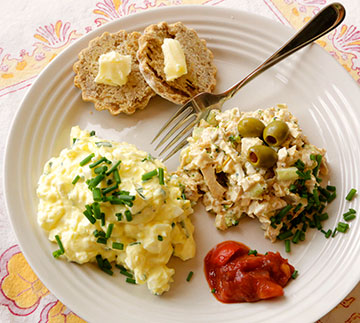Plantains look much like bananas and are one of several banana varieties. Plantain can be larger than bananas or almost the same size. Unlike bananas, however, they need to be cooked. I mean, they won’t kill you if you eat them raw, but seriously, they won’t taste good!
Make your morning Brunch Plate full of good things!

The food in the above photograph. Beginning with Trina’s Gluten-Free Brown Bread, a slice toasted on the left (it is good fresh, too) plus -Fermented vegetables, a slice of Brie Cheese, Celery, Parsley, and Cilantro Pesto, cooked beet slices, Sauteed Plantain Slices, and two fried eggs -cracked and crispy.
Breakfast or Brunch. They say it is the most important meal of the day… A small breakfast will suffice if you eat lunch, but if you have brunch, you will have lots of energy to keep you until dinnertime. This is an interesting way to do intermittent fasting and only eat twice daily.
About Plantain
Plantains are widely used in tropical areas where they are grown, but in recent years they have also become a popular grocery store item in the produce section of more northern climates.
Since discovering the health benefits of Plantain and that they are gluten-free, I have been including these in our meals from time to time, mostly for breakfast or brunch. Often when I am buying Plantain, I am asked by a passerby what they are and how to use them.
Trina
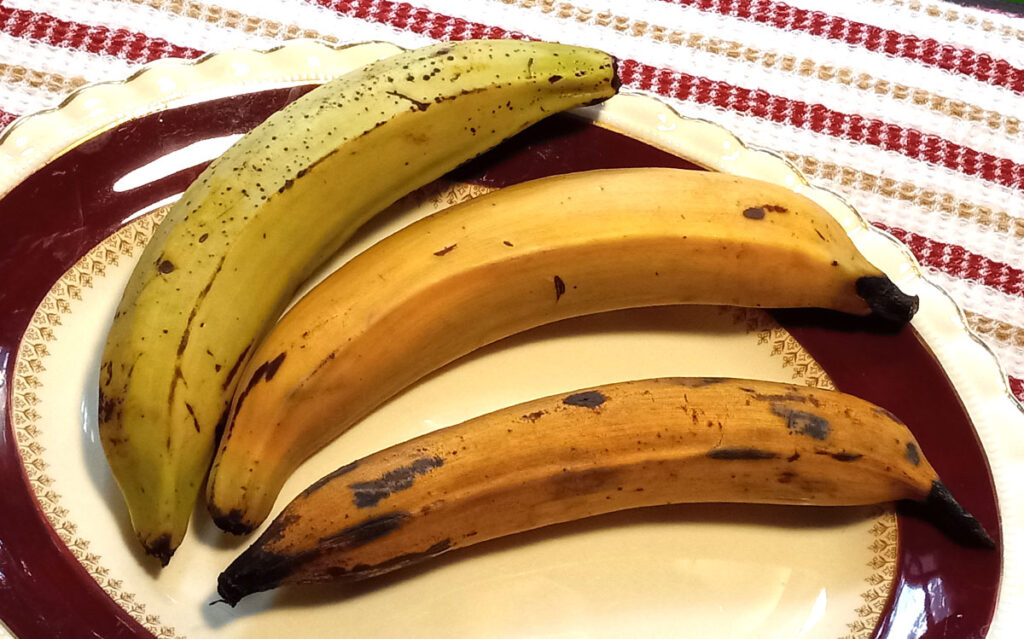
Unripe Plantains are a medium green color, and they turn a golden yellow with some brown areas when ripe. I like to purchase a few firm green Plantains and let them ripen slowly on my kitchen counter. They will ripen at different times, so I can choose the ripest ones to use in various recipes. Depending on how large it is, one Plantain can often be enough as a side dish for one or two people.
When they are ripe, cooked Plantains have a delicate sweet flavor and are less sweet than bananas. They taste delicious, and the flavor changes depending on their ripeness. Greener Plantains have firmer flesh and can be bland to the taste. These are good when grated, spread out in a pan with a little hot oil in the bottom, and fried with a sprinkling of sesame seeds on top. They can be quite crisp, almost like a cracker. The ripe Plantain will be softer.
Plantains are gluten-free and provide several essential nutrients contributing to a healthy diet.
Carbohydrates:
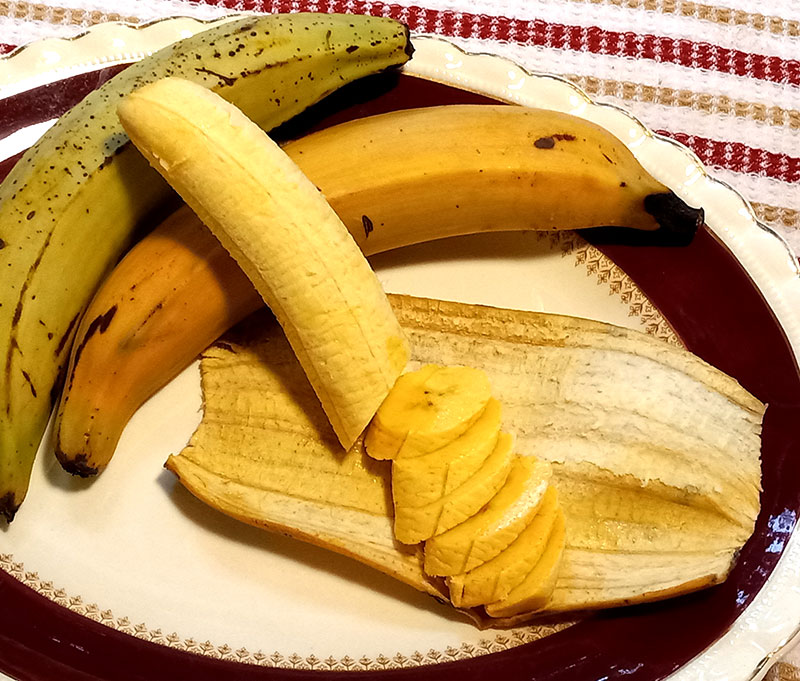
Plantains are primarily composed of carbohydrates, mainly in the form of starch, which provides a good source of lasting energy. Plantains give a more prolonged sense of fullness without feeling bloated, and the energy burn lasts longer. For instance, eating a banana will give a great burst of energy but will dissipate faster than eating Plantain. The starch contained in Plantain, when they are green, is a kind of resistant starch which is great for gut health. Ripe Plantains have a sweeter starch profile.
A little plantain goes a long way to enrich your diet, you may want to eat a lot once you taste it, but as with anything else, moderation is key.
Fiber:
Plantains are rich in dietary fiber, which is essential for a healthy digestive system. The fiber from Plantains improves gut health and may help lower cholesterol levels.
Vitamins in Plantain: (genus Musa)
- Vitamin C: An essential antioxidant that supports the immune system and helps the body absorb iron.
- Vitamin A: Important for vision, skin health, and immune function.
- Vitamin B6 (Pyridoxine): Plays a role in metabolism and the formation of neurotransmitters.
- Folate (Vitamin B9): Essential for cell division and DNA synthesis.
Minerals in Plantain
Potassium: Important for maintaining heart health and regulating blood pressure.
Magnesium: Supports muscle function, bone health, and energy production.
Iron: Necessary for red blood cell production and oxygen transport.
Antioxidant Properties in Plantain
Plantains contain various antioxidants that help protect the body’s cells from oxidative stress, boost the immune system, and may have anti-inflammatory properties. Eating Plantain helps to regulate glucose in the blood, improves digestive health, promotes heart health, enhances brain function, lowers cholesterol, and strengthens bones.
Protein: While plantains contain some protein, it is not a significant source compared to other foods like legumes, nuts, and seeds.
Plantains are quite a versatile fruit.
They can be fried, boiled, baked in the skins or used in baking, or grilled. The inner flesh of the Plantain, when dried and ground into flour, is a creamy white and has a delicate flavor. It can be used in baking or as a dredging flour. When dried before cooking, it is best used in recipes with further cooking required, such as cookies.
Plantain Skin Usage
- Plantain skins are thicker than banana skins and are generally discarded or composted. Some people rub the inner peels over stainless steel pots, sinks, or other cooking utensils to clean stains prior to washing.
- Plantain skins can be saved in the freezer and then dried in the oven and ground into a powder. This can then be blended with other gluten-free flour to add fiber and nutrition for baking. The dried skins turn brown when being dried to a crisp in the oven. The ground Plantain skin flour is consequently a dark brown color and has a dusky, slightly smoky semi-sweet flavor. In Nigeria, this flour is prized for baking cookies. It is tasty when used in a bread or cookie recipe. Plantain skin flour can also be used as a natural fertilizer for small pots in your garden.
Preparing Plantain for Cooking
Always wash the plantains in light soapy water, rinse well, and pat dry the skins before slitting down one side and peeling the skin off. Ripe plantains are easier to peel, while the skin of green plantains is a little harder to get off. Sometimes the skin may have to be peeled off with a knife if it does not come off easily.
Plantain in Recipes
Plantain has been eaten for centuries in southern climates, and cooking methods and recipes are just as plentiful. Grannies probably have all kinds of tips and secret recipes.
Although this article has a recipe for delicious Sauteed Plantain Slices as a side dish for a Breakfast or Brunch plate, here is a list of other potential recipes.
- Plantain Bread – Usually blended with either wheat or gluten-free flour, Plantain can be added to flatbread, yeast bread, muffins, and snack cakes.
- Plantain Casserole –also known in Puerto Rico as Pastelón de Plátano Maduro. The combinations are endless as slices of Plantains are layered between cooked lentils, sauteed ground beef, pulled pork, chicken, or turkey and topped with cheese.
- Plantain Lasagna –Plantain is used in place of pasta.
- Plantain can be Baked in the skins either in the oven or on the BBQ. Slice open and serve with a dollop of butter, sour cream, and cheese, almost like a baked potato. Just scoop out the soft sweet center and enjoy.
- Plantain Dumplings –are grated Plantain flesh blended with flour, salt, pepper, and spices. Knead into a ball and pinch off chunks, and then add these to hot bubbly sauces and stews. Plantain does not take long to cook, just 2 or 3 minutes which makes this kind of recipe easy.
- Plantain Porridge –a bowl of warmth that is easy on the stomach and a kind of comfort food.
Grate the flesh of one or two green Plantains and set aside.
In a medium pot, place 2 cups of water and 1 cup of coconut milk, a tsp. of cinnamon, a pinch of nutmeg, and a pinch of Pink Himalayan Sea salt.
Bring to a boil.
Add the grated Plantain and turn down the heat to simmer while stirring continually for about 3 minutes. Add a tsp. of vanilla and serve with thick cream.
An Easy Recipe for Quick Sauteed Plantain Slices
1. One medium-ripe or fully ripe Plantain with the peel removed.
Enjoy!
2. Slice the inner white banana-like flesh into 1/4-inch oblong slices.
3. Place the slices in a pre-heated skillet in which you have poured a small amount of oil. Just enough to coat the bottom. I use a cast iron skillet. Cook covered for about 2 minutes. Lift the lid and turn the Plantain over.
4. Cook until browned on both sides and serve. Never mind if they turn a little black instead of golden brown. It just adds to the sweet aroma and an even more delicious taste.
Once you eat them, you will want to have some often. A great addition to any meal, especially Brunch!
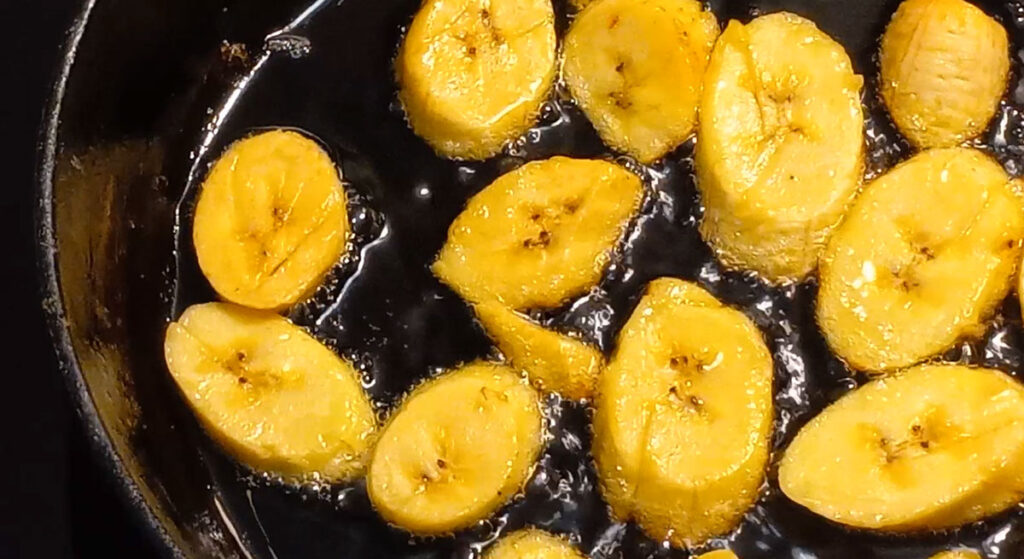

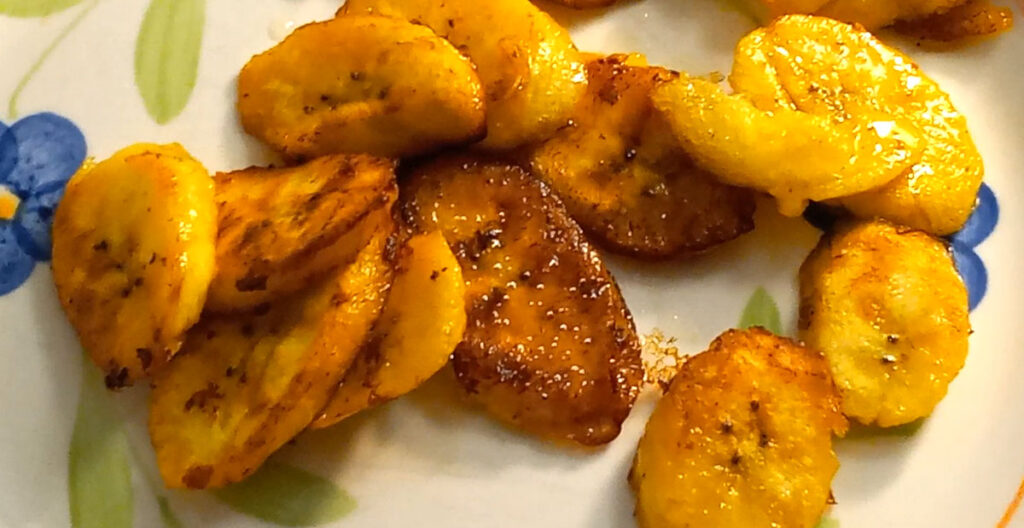
I hope you will try some plantain soon. Fair warning, though, once you do, it will be a regular menu item!
Please join my newsletter, where I muse about interesting things on a variety of subjects.

